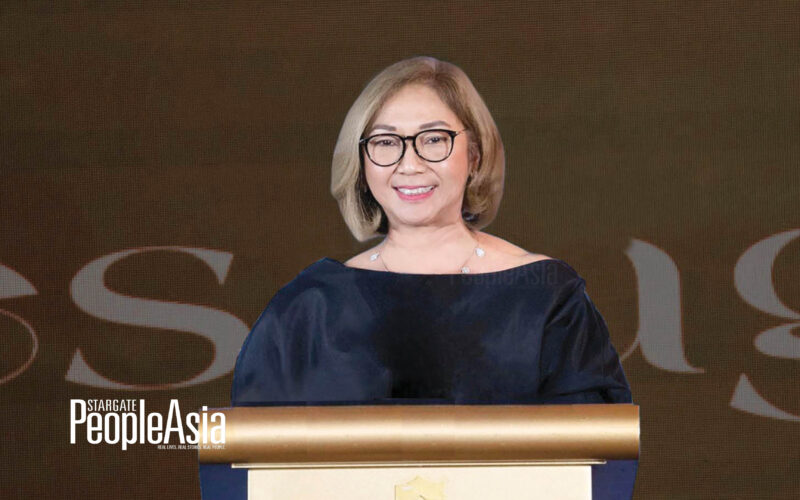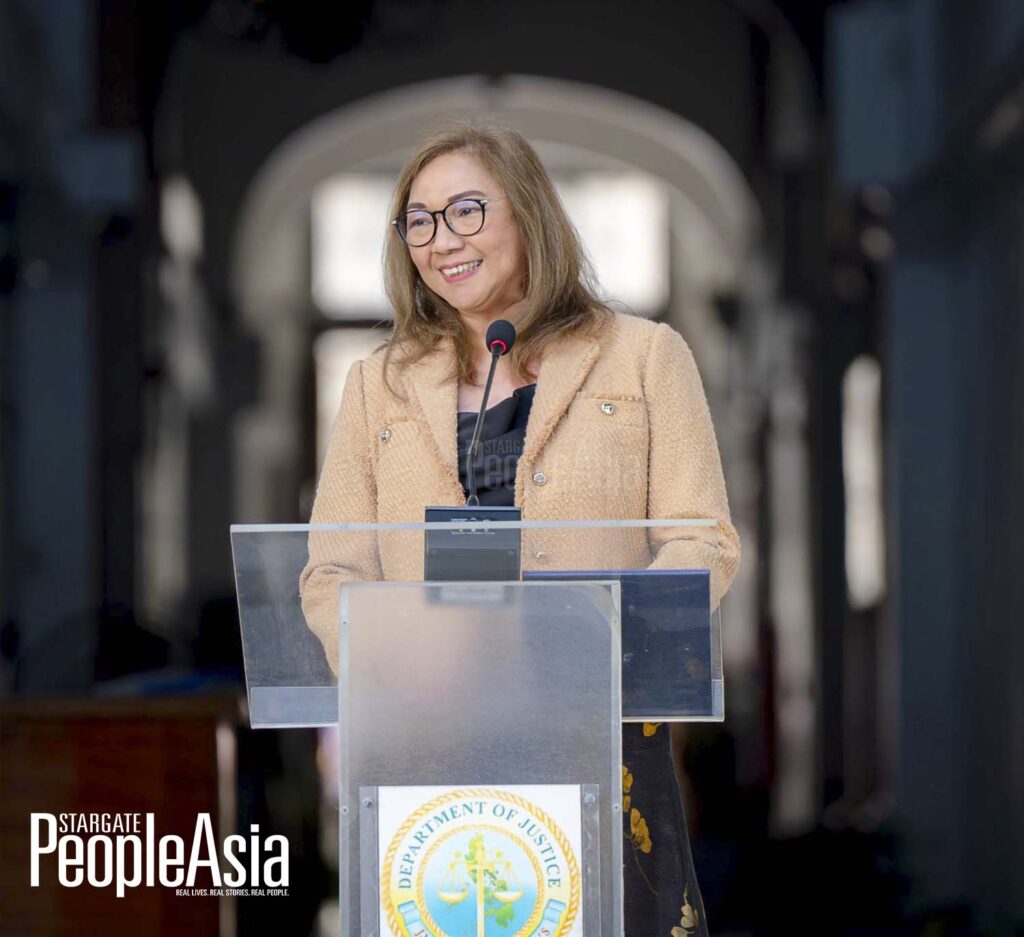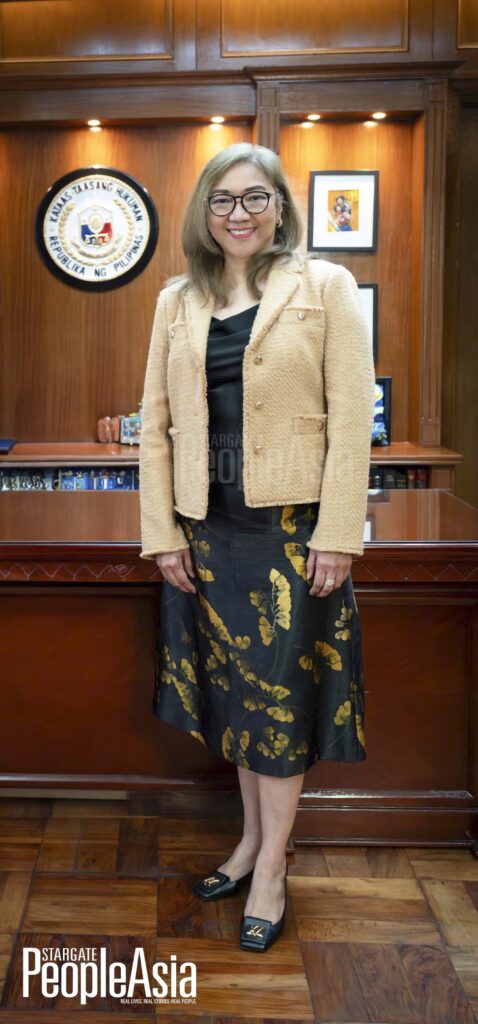Whether through advocating women’s rights or championing reforms that empower young lawyers to find fulfillment — even before they are appointed to high positions — this associate justice and passionate writer proves that the courts should neither be a cold nor heartless place.
By IVY LISA F. MENDOZA
It was a moment filled with both pride and bittersweet emotion as Supreme Court Associate Justice Maria Filomena Dumandan-Singh first marched into the session hall donning that black and purple velvet justice’s robe. Pride, because her relentless hard work and dedication to the law had brought her to the country’s highest tribunal; yet bittersweet, because the people she most wanted to share that moment with — her beloved parents — were no longer around to witness it.
Raised by her mother, lawyer Clara Dizon Dumandan-Singh, and a charismatic father, Harry Francisco Singh, who was active in local politics in Marikina, “Monette,” as her peers would fondly call her, is living out a dream her father always envisioned for her. “My dad was diagnosed with small-cell cancer in 2019, and that made me urgently want to apply for the Supreme Court while he was still around,” she says.
Sadly, her parents passed on without seeing her occupy that office in Padre Faura. But what she has been left with is a life shaped by discipline, purpose and an enduring love for writing, first, and, later on, law.
Destiny’s choice
“I didn’t want to have anything to do with the law,” Singh declared firmly on two separate occasions in her life — only to have fate challenge that resolve.
First, she wanted to become a creative writer, not a lawyer. Majoring in Imaginative Writing at the University of the Philippines, Singh was all set to become a wordsmith under the guidance of her illustrious mentors and teachers, among them National Artist for Literature Francisco Arcellana and National Artist for Theater Amelia Lapeña-Bonifacio. In her college senior year in 1987, at the UP Creative Writing Workshop, she even won two awards — the Best Short Story award, as judged by National Artist N.V.M. Gonzalez, and the Best One-Act Play, with National Artist Tony Mabesa, among the jurors.
“I was fortunate to train under two National Artists,” Singh shares, reminiscing about her early writing days. “I loved the UP vibe. My professors didn’t care if we attended class or not–exactly the freedom I was grateful for, having come from a rigid primary and secondary education in an exclusive girls’ school run by Benedictine nuns. In UP, I learned how to maximize the freedom on campus to do the things that I wanted to do.”
Except that this was not what her feisty lawyer mom wanted her firstborn to do. One fateful day, her mother took her to Ateneo to take the law school entrance exam — something Singh hadn’t planned on, let alone prepared for. She nevertheless aced the test and, in the end, was willingly steered by her mother’s influence toward law.
Serendipitous detour
Despite her initial hesitation, Justice Singh pursued law with distinction. Her early career is marked by pivotal moments — particularly as a young, pregnant lawyer receiving dismissive comments from senior colleagues about balancing motherhood and law. “I was even asked by a female lawyer who was interviewing me for a job how I expected to cope with work being a mother, and then she showed me her closet in the office full of clothes because she said she practically lived in the office. I left and never went back,” she recalls.
She also cites instances of female judges who, instead of offering mentorship, would discourage younger women from applying for judicial positions. “I approached a female judge whom I used to look up to who told me, ‘You young ones should apply as judge when you are no longer at a child-bearing age.’ That’s because the workload of female judges on maternity leave was passed on to them,’” Singh recounts with disappointment.
But rather than let these experiences deter her, they fueled her commitment to reform. “I made it a point that I would be different. I wouldn’t be harsh to younger lawyers, male or female. Instead, I would help them. In my classes, I always incorporate this value of kindness. I tell my
students to be kind to one another and not pull each other down, that they should all help each other succeed,” Singh shares, adding that “success’’ is a relative term and these lawyers do not have to wait to be in a high position to feel fulfilled.
No turning back
Exasperated by what she saw happening in private practice, and the legal system in general, Singh once again declared that it was over between the legal profession and her in her younger years.
“I asked myself, bakit ganun (Why is it like that)? Why do those who should win, lose and vice versa? I wasn’t also getting that sense of fulfillment. I am getting out, I told myself,’’ she recalls.
However, a mentor asked her a question point blank that jolted her back to her senses. “My mentor asked me, ‘Ang dami mong reklamo, ano na ba nagawa mo (You have so many complaints, but what have you done about them)? Stop complaining.’ That made me look into myself and reflect on what I could really do. I took the bold step of applying as a judge to challenge myself that if I could institute changes first in my courtroom, then there may be a chance to change the system,’’ she says.
The young lawyer wasn’t being careful about what she wished for. Much to her shock, her first assignment as a metropolitan trial court (MTC) judge in 2002 was to oversee the “black sheep” of MTCs in Quezon City, the one that was notorious for personnel being entrapped, or going AWOL for engaging in fake cash bonds.
“After recovering from the initial distress, I told myself that it’s okay, I’d just do what I have to do. So, I would go to work very early, and leave late. I led by example. I even posted signs that said, ‘No donation, no gifts, no solicitation,’’’ she narrates.
Justice Singh brought discipline and integrity to the position, banning gifts and donations, and setting an example of hard work and ethics. Her leadership began to transform the court, as she herself began to get recognition for a job well done.
From August 2009 to June 2010, Justice Singh was a Hubert H. Humphrey Fellow on Court Management and Judicial Education of the US Department of State in the US. She worked with the World Bank’s Institutional Reform Sector, specifically on judicial reform projects in Europe and Central Asia. She also became the first Philippine Judicial Fellow at the Federal Judicial Center in Washington, D.C., the educational arm of the US Supreme Court and the counterpart of the Philippine Judicial Academy (PhilJA).
On March 14, 2014, Justice Singh was appointed as an Associate Justice of the Court of Appeals. She served as the chairperson of the Court’s Committee on Continuing Judicial Education, and as a member of the Court’s Committee on Rules, Committee on Gender and Development, and an editor of the Court of Appeals Journal.
On May 18, 2022, Justice Singh took her oath before Chief Justice Alexander G. Gesmundo as the 194th Associate Justice of the Supreme Court.
Championing women’s rights and judicial reform
Singh’s experiences with gender-based violence and discrimination cases have been particularly formative. As she presided over rape and incestuous crime cases, she felt compelled to shift the traditional legal approach. In her chambers alone, Justice Singh decides from three to five rape cases weekly. Easily, that’s about 40 to 45 rape cases a month for the entire Court.
“Can you believe it’s that many, and that majority of the cases are incestuous? Rape is often handled like a checklist — was the victim a minor? Was it an incestuous case? Then we convict and award the damages. But wait, why is no one checking on the victim, is the victim made whole again, does the victim feel vindicated by the process?” she asks.
Believing that justice must also encompass emotional recovery for the victims, Singh’s decisions began to focus not only on legal justice, but also on the emotional and psychological recovery of victims, often referring them and their families for counseling.
Singh also expressed sadness over the Supreme Court ruling in 2022 that allowed the use of the Anti-Violence Against Women and their Children (VAWC) Act by males to sue females.
“I was so, so, so sad when we lost through votes. But I promise that when we find the correct case and the correct platform, we will try to change it,’’ she vows, as she believes it distorts the essence of a law designed to protect vulnerable women and children.
This commitment to gender equality led to Singh being elected in 2023 as a director for the Asia Pacific Region of the International Association of Women Judges (IAWJ), an organization dedicated to empowering women judges to end gender bias and promote human rights.
Still her first love
At the back of Singh’s desk in her office lies a pink Olympia portable typewriter, made in 1966, the year she was born. It was a gift from her son to remind and encourage her not to forget that she could always go back to fiction writing, her first love.
“Until now, I write short fiction stories. I have completed at least nine,” she shares, her eyes twinkling. “My stories aren’t about the law or corruption, which is probably what people would expect. They’re real stories, about everyday things and watching different people doing different things. I’m just a keen observer of life.’’
She admits that her hesitance to publish stems from the intimate nature of her work. “Even if I’m writing about something as simple as waiting for a bus, the stories are intertwined with my own life in ways that people might not realize unless I tell them. Maybe that’s why I’m protective of them,” she shares with a laugh.
Her passion for storytelling goes beyond personal fulfillment. Singh recently completed two stories — one on bullying and disability, and the other on body autonomy — targeted to educate children in public schools. “I wrote them in conversational Tagalog because I want kids to understand these topics. I want to equip them with the knowledge that might help prevent cases like incestuous rape,” she explains.
Though these stories touch on sensitive issues, Singh is careful not to approach them from a legalistic perspective. “There’s no element of saying, ‘This is prohibited by law.’ It’s all conversational, something kids can relate to and grasp easily,” she describes.
Singh also approaches her judicial writing with the same passion she has for storytelling, viewing it as a puzzle where each piece of law must fit perfectly into place.
“I love writing decisions but is more than just citing laws and precedents — it’s about making complex legal concepts understandable for the people affected by them. Decisions must be simple, straightforward and complete, and this is something I instill in my students as a legal writing teacher. It’s a crusade on my part,” she admits, ensuring that her decisions are accessible to everyone, not just lawyers.
Indeed, Singh’s journey is testament to her perseverance and resilience in the face of numerous challenges, including being a single parent while balancing the demanding nature of her career. Her four children, now grown, have been her greatest source of joy and support. “I couldn’t have done any of this without them,” she says. “They never complained, even when I brought work home. They understood that my service to the country is a service from them as well.”







